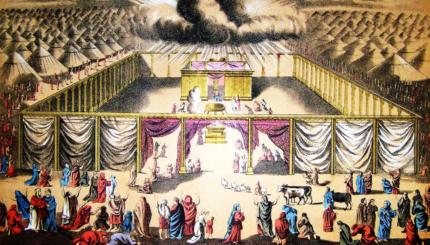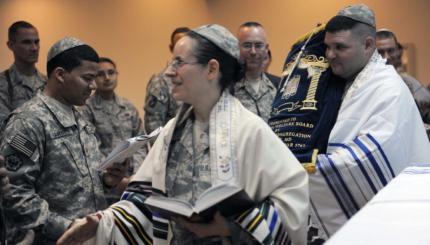Jewish life is turned around – so suggests this week’s Torah portion (Terumah) about the first Mishkan (ritual focus of cultic and religious life) in the desert. This ancient narrative offers profound reflections on the denominational ins and outs of modern Jewish life.
One way to understand Jewish history is in denominational terms. Before modernity, Jews in their social, linguistic and philosophic diversity had no denominations like the streams of Christianity (e.g. Anglican, Baptist, Catholic, Dutch Reformed, Evangelical, etc.). Painting with a broad brush, Reform Jewry was a late 18th century social-theological reaction to the
Haskalah
(Jewish Enlightenment). Orthodoxy was a self-protective reply to Reform. Conservative Jewry was a 19th century response to Reform. Reconstructionism evolved in the 20th century from Conservative Jewry as a reaction to social and scientific modernity. By the late 20th century, Jewish denominations established seminaries, congregational affiliation systems, dues structures, governance methods, employment eligibility criteria, prayer books, theological reality maps, and committees to apply Jewish law (or reject Jewish law entirely).
Amidst these denominational fault lines, we can forget that Jewish denominationalism is barely a blip, just two centuries over a span of millennia. What’s more, the denominational tide is going out. Now-mainstream seminaries of ALEPH: Alliance for Jewish Renewal, the Academy for Jewish Religion-New York, the Academy for Jewish Religion-California, and Hebrew College arose to ordain rabbis outside denominationalism, preparing clergy to serve increasingly fluid, porous and diverse Jewish communities. The Internet is democratizing access to Jewish learning and resources, fueling continued rise of independent synagogues and chavurot. Denominational synagogues, in turn, are bucking “mother ships” on dues structures, guild limits on who may apply for pulpits, and centralized policies about Jewish status. Initiatives like OHALAH (the trans-denominational rabbinic association for Jewish Renewal) and CLAL’s Rabbis Without Borders testify to the porousness of modern Jewish life, and the boundary-challenging experiences that are their primary organizing forces.
This counter-denominational trend is re-shaping Jewish demographics. The 2013 Pew Study found that fully 22% of U.S. Jews – and 32% of Jews born after 1980 – reject all labels on their religious identity. Today fully 30% of U.S. Jews actively practicing Judaism claim that their Judaism has no denominational label. Second to Reform, which claims allegiance of 35% of U.S. Jews, today’s largest denomination in active U.S. Jewish life is no denomination at all. This trend is quickening, and denominational leaders know it. Among the many social and economic causes of denominational decline, waning denominational identification is top among them. Partly as a result, the number of Conservative congregations declined by 25% since 1985; in the 2000s, the Reconstructionist Movement merged its synagogue arm and rabbinical college.
We are witnessing the retrenchment of denominationalism in U.S. Jewish life. The question isn’t whether it is so, but what we make of it.
Enter this week’s Torah portion. To build the Mishkan as a focus for the Indwelling Presence of God, Torah recounts that Moses was to receive gifts from everyone with willing hearts (Ex. 25:2). Their gifts were radically diverse in content, composition, color and style (Ex. 25:3-7). The purpose was to build a sanctuary from their diversity, so God could dwell b’tocham – not within “it” (the Mishkan) but within “them” (the people) (Ex. 25:8). Together these images evoke a collectivity in which everyone shares diverse gifts to establish the immanence of God among us – with no barriers of denomination, tribe, race or caste to divide the people.
To put a fine point on it, the Indwelling Presence (Shechinah) dwells not amidst any subgroup but among the entirety. So wrote the Sfat Emet in 1870: “Shechinah dwells among all the Children of Israel together.” So teaches the Zohar (3:202a): “The whole of the people are the vessel for Shechinah.” Spiritually speaking, the modern blip of denomination is entirely besides the point.
Even more telling are the kruvim (cherubim) atop the Mishkan, which in this week’s Torah portion faced each other (Ex. 25:20). In pre-exile Jerusalem, however, the kruvim faced not each other but the Temple (2 Chron. 3:13). Talmud’s rabbis noted this inconsistency. They reasoned that when the people behave well and honor God, the kruvim face each other; but when the people behave poorly and dishonor God, the kruvim face the Temple (B.T. Bava Batra 99a).
In modern spiritual terms, we ourselves are the kruvim. Our calling is first to face each other, not any dogmatic structure. When we face each other – inclusively, making room for all, accepting everyone’s heart gifts – we honor Torah’s call to build a Mishkan for the immanence of God to dwell among us. When instead we face first a denominational or dogmatic subgroup, we re-trace Talmud’s definition of poor behavior that dishonors God and defies our spiritual purpose. The Jewish sense of God can only dwell amidst our entire collectivity: no mere part will do.
Denominations bring scholarship, investment, organization and purpose. Klal Yisrael needs those benefits, and denominations continue to be vital vehicles for them. For those reasons, Jews outside denominationalism do wrong to glibly demonize denominations as inherently corrosive of Jewish spirituality. By the same token, denominations do wrong to diminish or disenfranchise Jews and Jewish leaders whose spiritual or community affiliations grow outside denominational structures. The Mishkan needs their diverse gifts no less. Our failure to learn these lessons risks turning each other into Others, turning the spiritual kruvim away from each other, turning Jews away from our collective spiritual calling.
For the ins and outs of denominational life, the upshots are clear. Denominations must drop bans on which legitimate seminaries’ rabbinic ordinees may apply for pulpits: Jewish community is a spiritual body, not a collection of protectionist mercantile guilds. Jews are voting with hearts, minds and wallets against exclusivist denominational strategies, and denominational leaders must evolve accordingly. For their parts, non-denominational Jews must drop their “ugly stepchild” narrative of exclusion and subjugation. Denominational successes aren’t affronts to chavurot, independent communities and unaffiliated seminaries. Non-denominational leaders would do well to learn the denominations’ wise use of organizational tools to enrich the collectivity of Jewish life.
Learning these lessons will help us turn toward each other anew, like the kruvim atop history’s Mishkan. Perhaps by turning toward each other in these ways, we can build a new Mishkan worthy of that name – a collectivity fit for the Indwelling Presence of God among us all.
Dedicated to the memory of R. Zalman Schachter-Shalomi, zeide (grandfather) of Jewish Renewal, who taught that “the only way to get it together is together.”
Torah
Pronunced: TORE-uh, Origin: Hebrew, the Five Books of Moses.
Zohar
Pronounced: ZOE-har, Origin: Aramaic, a Torah commentary and foundational text of Jewish mysticism.



